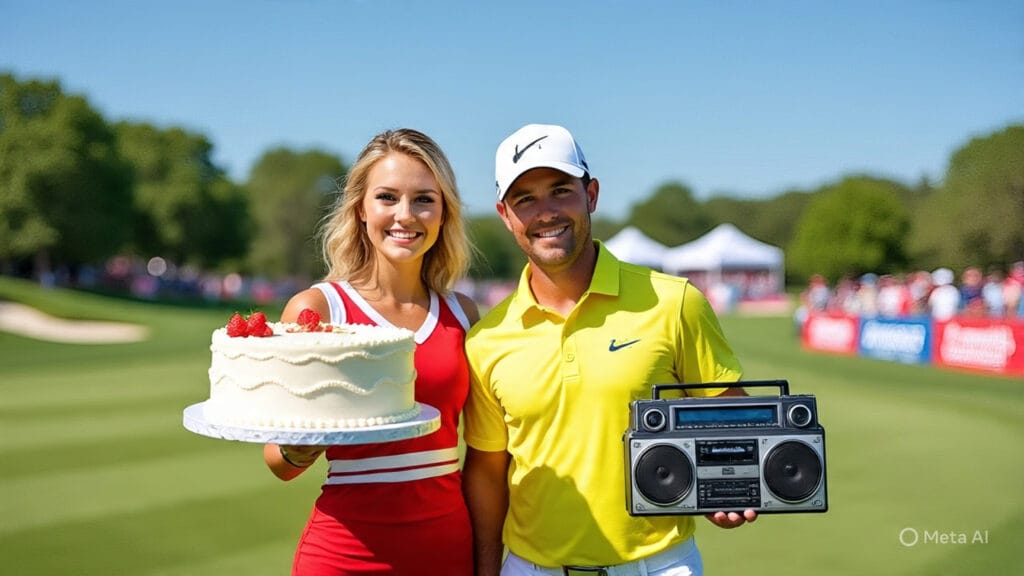Top Takeaways and Key Concepts
Please Note: This post may contain affiliate links. If you click one of them, we may receive a commission at no extra cost to you. As an Amazon Associate, I earn from qualifying purchases.
→ Practice under pressure by simulating real-game stress with timed challenges or competitive drills.
→ Visualize success before big shots to train focus and reduce performance anxiety.
→ Develop a consistent routine to maintain calm, confidence, and control during high-stakes moments.
→ Embrace friendly competition to test skills, build resilience, and adapt to real-course pressure.
→ Reflect after each session to identify strengths, learn from mistakes, and improve steadily.
Summary of This Article
This article shows how golfers can strengthen performance under pressure through realistic practice, mental conditioning, and game-like challenges. By visualizing success, building routines, and reflecting on results, players develop focus, confidence, and composure. Practicing with purpose turns stress into strength and prepares golfers to perform their best when it counts most.
Video Summary
It really is a game of waiting and being right, isn't it? And wow, when you're ready to make a big putt, it could seem like everyone is watching. The sun is shining, your friends are nearby, and it feels like everyone is holding their breath. Just thinking about it makes my palms sweat!
It's really vital to get ready for those heart-pounding situations. Practicing under pressure can be helpful. While you practice, picture yourself on the course. Do some little things for yourself. Before you go on, try to make five short putts in a succession. It will make your heart race like a real game.
You could also play games with friends where you have to make certain shots or get funny penalties if you happen to miss. This has a tendency to add some extra tension and makes practice more fun!
Do you have a different thought? Think about those tough circumstances before they happen. Picture yourself making that perfect putt when you are calm and confident. You know how powerful visualizing can be!
Every time you practice like this, you're getting ready for the big events on the course. It helps you make effective use of all that anxious energy. You'll be able to walk up to that ball with confidence and strength, like you've done it a million times before.
We all get anxious from time to time, but we can get through it as a group! You can do this!
The Importance of Pressure Practice

Hey, have you ever noticed how things feel different when there's something at stake? It’s like being in a movie where all eyes are on you as you strive to save the day—or at least save par.
It's important to practice under pressure because it helps our brains learn how to stay focused when it matters most. I remember playing in a competition in my area when my hands were shaking so much that I could barely hold my club. Spoiler alert: I missed the putt!
It's funny how placing ourselves in high-pressure situations during practice can truly impact how we play. When we only hit balls on an empty range, everything seems quiet and easy. But what about when we go on the course? Oh no! It's a completely different story.
Think about how it would feel to be out there with your buddies watching you. The pressure is on! Like performers do before a big show, we need to add some “drama” to our practice. It helps us get ready for the times when it matters.
So, how can we make our training more fun? One idea is to make small challenges. While your pals cheer you on, or perhaps tease you a little, attempt to make three putts in a row. That will undoubtedly make things more interesting!
Another fun option is to play games where you have to make certain shots in a particular amount of time or else you have to face ridiculous penalties. For example, if you miss a shot, you could have to sing a silly song. This puts more pressure on you, but it also makes practicing seem less serious and more fun.
You may also practice on the range while it's busy. Being around other golfers might make you feel like you're being observed, which is a wonderful way to get used to pressure.
It can also help to picture such hard times before they happen. Imagine everyone watching you make that hard putt. It sounds easy, but it actually does work!
We're becoming better at this every time we practice, which will help us when it truly counts. You have what it takes; just keep going even though you're nervous!
Setting Up Game-Like Scenarios
 Let's have a look… One smart approach to do this is to make practice sessions feel like games. This could mean inviting friends or other golfers to play a friendly game with you where every shot counts.
Let's have a look… One smart approach to do this is to make practice sessions feel like games. This could mean inviting friends or other golfers to play a friendly game with you where every shot counts.
You could host a mini-tournament where everyone takes turns making shots while others watch and cheer (or boo). You can believe me: having someone else observe you all the time will make you pay attention.
Setting time limitations is another method to do this. It would be very stressful if you only had 30 seconds to hit each shot. This makes you have to make judgments quickly and provides you an adrenaline rush that seems like what you would feel when you have money on the line.
Even if you're only playing with friends, you might wish to use scorecards. Players are responsible for keeping track of scores, which makes them assume that every swing is crucial.
Mental Conditioning Techniques

Getting your mind ready is equally as crucial as getting your body ready. Visualization exercises could help us get ready for the stressful times on the course.
Take a few minutes to picture yourself doing well under pressure before you head out to play or practice. For instance, imagine making that birdie putt while your pals cheer you on.
Breathing techniques can also help you relax before you get important shots. When you're really stressed, take deep breaths through your nose and slowly through your mouth. It might sound simple, but it works!
This strategy helps us stay calm when things are crazy and keeps our hearts from beating quicker than our swings.
And speaking of imagery, don't forget to look at what you did after the shoot! After each round or practice, think on what went well and what didn't go as planned. If we learn from our mistakes today, we won't be surprised later!
Embracing Competition

Accepting competition, even with ourselves, can help us get a lot better! When we play friendly matches against other people, we learn a lot about how we do under different amounts of stress compared to when we practice alone.
Think about joining local leagues or tournaments. They give you a controlled environment where the stakes are higher than in regular games with friends (and yes, they generally have refreshments afterward!).
Competing often helps us learn what is expected of us and practice the abilities we will need when we face tougher opponents in the future.
I remember my first league game. I was nervous yet eager as I walked onto the field with players who had been there before and didn't appear to care about anything around them (how could they look so calm?).
But you know what? That experience pushed me out of my comfort zone, and in the end, it helped me grow as an athlete and as a person!
The Power of Routine

Making pre-shot rituals is also helpful when you practice in settings that are like a game!
Routines help keep things steady in the middle of chaos. A small ritual that soothes your nerves before that big shot can mean the difference between success and failure!
For example, imagine this: a golfer stands over their ball, takes three deep breaths, and then imagines their target before making a perfect swing (insert dramatic music).
Adding these kinds of habits to your daily routine helps your muscles remember things and keeps you focused even when unexpected distractions come along.
Keep in mind that doing something again and over again makes you more comfortable with it, which develops your confidence!
Conclusion: Preparing for Success
In short (OK, I'm done now!), practicing golf under pressure doesn't have to be scary; it can be fun!
We become ready for more success when it truly matters by immersing ourselves in game-like circumstances in numerous ways, like playing competitive rounds with friends or employing mental training.
The next time you're at the driving range or putting green and don't care if you miss putts or hit shots perfectly straight… Instead, push yourself!
Embrace the butterflies in your stomach because they imply that you can grow if you step outside of your comfort zone!
Featured Snippet: Practicing golf under pressure helps players stay calm, focused, and confident when it counts. By simulating real-game stress through drills, competitions, and routines, golfers learn to manage nerves, improve decision-making, and perform consistently under tension. Turning pressure into practice builds both mental strength and reliable performance.
Frequently Asked Questions
Why is practicing under pressure important in golf?
It trains your mind and body to stay focused and confident during real competitive moments on the course.
How can I simulate pressure during practice?
Create time limits, track scores, or compete with friends to mimic real-game tension and focus.
What mental techniques help with golf performance?
Visualization, deep breathing, and positive self-talk help manage nerves and sharpen mental control.
How does competition improve my golf game?
Friendly matches and tournaments push you beyond comfort zones, helping you adapt to high-pressure play.
What is a good pre-shot routine for staying calm?
Take slow breaths, visualize your shot, and repeat a consistent setup to reduce anxiety and build focus.
How can I turn nerves into better performance?
Channel nervous energy into concentration—see pressure as excitement and an opportunity to excel.
What should I do after each pressure practice session?
Reflect on what went well, identify areas for improvement, and celebrate progress to build confidence.
Suggested Resources:
The Mental Game of Golf
https://www.golfpsych.com/mental-game
How To Improve Your Golf Game Under Pressure
https://www.golfdigest.com/story/improve-golf-game-under-pressure

Kevin Collier is an avid golfer and contributing author at AIGolfTips.com, where he shares his passion for the game through expert tips, techniques, and gear reviews. With years of experience on the course, Kevin offers valuable insights for golfers of all skill levels, helping them improve their game and maximize their potential. Whether discussing swing mechanics or the latest in golf technology, Kevin's engaging approach aims to inspire and educate fellow golf enthusiasts to elevate their performance and enjoy every moment on the green.




